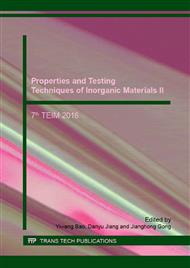p.204
p.210
p.215
p.220
p.225
p.230
p.235
p.240
p.245
Domain Walls and Thermal Aging Stability of (K,Na)NbO3-Based Ceramics in Tetragonal Phase
Abstract:
Thermal depoling behaviors of (K0.50Na0.50)0.94Li0.06NbO3 and (K0.50Na0.50)0.96Li0.04(Nb0.85Ta0.15)O3 ceramics possessing tetragonal crystalline structure at room temperature have been studied. By comparing the difference in these two compositions during annealing treatment, we provide visual evidence that different types of ferroelectric domain walls play different roles in the thermal depoling. The study results show that the drop in piezoelectric properties can be mainly attributed to the motion of 180o domain walls below the Curie temperature. When the thermal aging temperature is close to the Curie temperature, the reduction of piezoelectric properties is caused by the movement of 90o domain walls. The (K0.50Na0.50)0.96Li0.04(Nb0.85Ta0.15)O3 ceramic with fewer 180o domains shows very good thermal ageing stability from the low experimental temperature limit of −60 °C up to high temperatures close to TC.
Info:
Periodical:
Pages:
225-229
Citation:
Online since:
January 2017
Authors:
Price:
Сopyright:
© 2017 Trans Tech Publications Ltd. All Rights Reserved
Share:
Citation:


